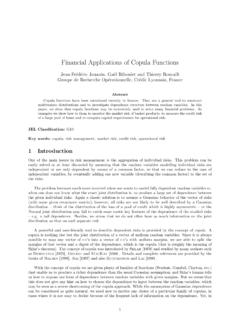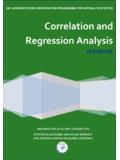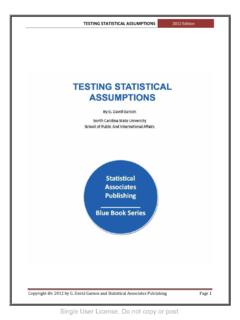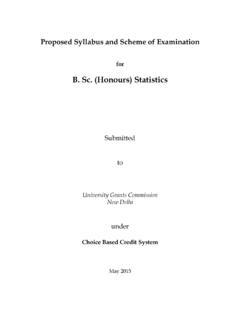Transcription of Testing for Independence Between Two Covariance …
1 Biometrika TrustTesting for Independence Between Two Covariance Stationary Time SeriesAuthor(s): Yongmiao HongSource: Biometrika, Vol. 83, No. 3 (Sep., 1996), pp. 615-625 Published by: Biometrika TrustStable URL: .Accessed: 22/11/2013 14:17 Your use of the JSTOR archive indicates your acceptance of the Terms & Conditions of Use, available at ..JSTOR is a not-for-profit service that helps scholars, researchers, and students discover, use, and build upon a wide range ofcontent in a trusted digital archive. We use information technology and tools to increase productivity and facilitate new formsof scholarship.
2 For more information about JSTOR, please contact .Biometrika Trust is collaborating with JSTOR to digitize, preserve and extend access to This content downloaded from on Fri, 22 Nov 2013 14:17:02 PMAll use subject to JSTOR Terms and ConditionsBiometrika (1996), 83, 3, pp. 615-625 Printed in Great Britain Testing for Independence Between two Covariance stationary time series BY YONGMIAO HONG Department of Economics, Cornell University, Ithaca, New York 14853, SUMMARY A one-sided asymptotically normal test for Independence Between two stationary time series is proposed by first prewhitening the two time series and then basing the test on the residual cross-correlation function.
3 The test statistic is a properly standardised version of the sum of weighted squares of residual cross-correlations, with weights depending on a kernel function. Haugh's (1976) test can be viewed as a special case of our approach in the sense that it corresponds to the use of the truncated kernel. Many kernels deliver better power than Haugh's test. A simulation study shows that the new test has good power against short and long cross-correlations. Some key words: Coherency; Cross-correlation; Independence ; Kernel function; Multivariate time series.
4 1. INTRODUCTION Recently there has been growing interest in Testing serial dependence within a univariate time series, Chan & Tran (1992), Robinson (1991), Skaug & Tjostheim (1993a, b). In contrast, relatively few attempts have been made to test dependence Between time series. Dependence Between time series is important in multivariate time series analysis. In econ- omics, for example, elucidation of various causalities Between time series is vital to forecasting and prediction. In exploiting dependence Between two Covariance stationary time series, say (Xe) and (Y,), one is often interested in Testing whether they are mutually independent.
5 Here we propose a test for uncorrelatedness Between (Xe) and (Ye) by first prewhitening X, and Y, and then basing the test on the residual cross-correlation function. Our test statistic is a properly standardised version of the sum of weighted squares of residual cross-correl- ations, with weights depending on a kernel function. The test is asymptotically normally distributed under the null hypothesis. Haugh (1976) proposed an asymptotically x2 test based on the sum of finitely many squares of residual cross-correlations.
6 Haugh's test can be viewed as a special case of our approach with the use of the truncated kernel. In an influential paper, Pierce (1977) used Haugh's test to investigate relationships Between a number of aggregate economic time series, and found little or no relationships Between most of the economic series. From an econometric point of view, this might be partly due to low power of Haugh's test. Indeed, Geweke (1981a, b) finds that Haugh's test often has low power. In this paper, we find that many kernels deliver better power than Haugh's test or the truncated kernel based test.
7 Within a suitable class of kernel functions, the Daniell kernel maximises the power of our test under both local and fixed alternatives. In addition, we avoid Haugh's assumption This content downloaded from on Fri, 22 Nov 2013 14:17:02 PMAll use subject to JSTOR Terms and Conditions616 YONGMIAO HONG that X, and Y, have an ARMA, autoregressive-moving average, representation, which, if misspecified, will invalidate the asymptotic distribution of the test statistic. In ? 2, we introduce the test statistic. Asymptotic normality is established in ?
8 3. In ?? 4 and 5, we investigate asymptotic local and global power. In ? 6, we examine finite sample performance of the new test in comparison with Haugh's (1976) test via Monte Carlo methods. All mathematical proofs are available from the author upon request. 2. THE TEST STATISTIC Throughout, we impose the following assumption on X, and Y,. Assumption 1. The stochastic sequence (Xe, Y,) is a bivariate jointly stationary linear process such that 00 00 Xt =E ajut-j. Yt =E bjvt-j (t = 1, ..,N), j=O j=O where (i) (ut) and (vt) are each an identically and independently distributed sequence, with E(ut) = 0, E(vt) = 0, E(u 2) = o2, E(v2) = o2, E(u4) < oo and E(v4) < xo; (ii) (aj) and (bj) are sequences of real numbers such that ZJ% Iaj I < 0, O bjIbxI < oo with ao = = 1.
9 Furthermore, IE0 ajzjl and IET objzjl are bounded away from zero for lzl A 1. This includes as special cases AR, autoregressive, MA, moving average, and ARMA models of finite but possibly unknown orders. For such linear processes, it is well known (Haugh, 1976, p. 379) that (Xt) and (Yt) are uncorrelated if and only if the innovations (ut) and (vt) are uncorrelated. Consequently, one can test Independence Between (Xt) and (Yt) by first prewhitening Xt and Yt and then Testing Independence Between the residuals, say (ut) and (Vt).
10 This approach, as pointed out by Haugh (1976), is much easier to handle and interpret, because it filters out the autocorrelation of Xt and Yt. Assumption 1 implies that Xt and Yt have an AR(00) representation: A(L)Xt = ut, B(L)Yt = vt, where 00 00 00 /00 A(L) = 1- ocL ,aL , B()=1-i,jLj = bjL (=L j=( j=L j=) with L a lag operator. We fit Xt by an AR(p) model. The ordinary least squares residual is At = Xt A(p),Xt(P)5 where Xt(p) = (Xt-1, .. , Xt_p)', and &(p) is the ordinary least squares estimator (N )-1 N 2p= i XEt(p)Xt(p)j E Xt(P)Xt.)





